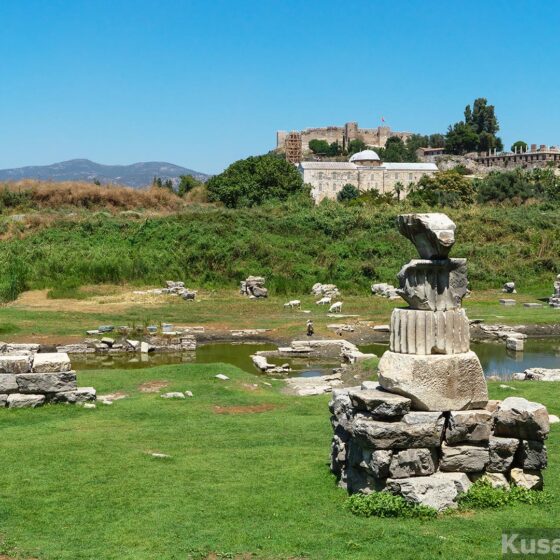Deep in the cradle of Western civilization, where the sun gilds the ancient stones and whispers of a glorious past fill the air, lies the city of Ephesus, a gem of Turkey’s Aegean coast. Stepping onto its timeworn cobbles, one feels an uncanny connection to the thrumming life that once filled its streets, markets, and grand edifices.
Among the echoes of its antiquity, the Temple of Artemis or Artemision whispers the loudest.
Today, it’s hard to imagine that the single lonely column standing in a marshy field was once part of one of the Seven Wonders of the Ancient World. But, close your eyes, and you might hear the soft rustle of the priestesses’ robes and the reverent murmurs of worshippers as they paid homage to Artemis, the goddess of the hunt, wilderness, and wild animals.
See also:
- A Self-Guided Tour of Ancient City Ephesus
- Biblical Ephesus: The Significance of Ephesus in Christianity
- Library of Celsus: A Testament to Ephesus Cultural Richness
There was a time when the Artemision was so much more than a temple. With its staggering 127 columns, each standing tall at 18 meters high, it was a symbol of the city’s grandeur. Its marble edifice and sculptured friezes, which represented the world’s artistic pinnacle, rendered visitors speechless. Famed for its beauty and size, it attracted pilgrims, merchants, and kings who left their marks, and sometimes their fortunes, behind.

Inside the statue of Artemis, a figure draped with ornate jewellery and guarded by a pride of lions drew wonderment and veneration. Tales of her divine power were echoed in the hallways, a testament to her majesty.
But history is a relentless tide. The temple was destroyed and rebuilt several times over centuries, ravaged by the elements, arson, and eventually, the Goths.
By the time of its final destruction in 401 AD, Christianity had taken root, and the temple was not rebuilt. Today, its stones lie scattered across museums around the world, with the British Museum housing the largest collection.
However, Artemision’s glory lives on in the shared human consciousness. Though only fragments remain, they serve as reminders of our collective history, a beacon guiding us back through time’s winding path.

Getting to Ephesus
Getting to Ephesus is relatively straightforward, with regular buses from Selcuk, just a few kilometres away. If you’re coming from further afield, like Istanbul or Antalya, consider taking a flight to Izmir, and then a bus or train to Selcuk.
See also: Ultimate Guide to Getting from Izmir Airport to Kusadasi
As you stand before the Temple of Artemis’s solitary column, imagine the grandeur that once stood here, the air vibrating with ancient prayers and the walls adorned with unrivalled beauty. The temple may be a ghost of its former self, but its story remains vibrant, echoing across the millennia.
It’s a journey back in time you won’t want to miss.
Contact Us
Last updated on February 10, 2024




